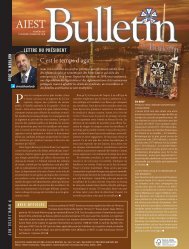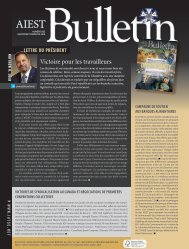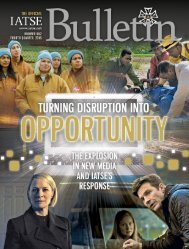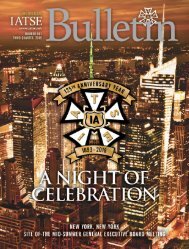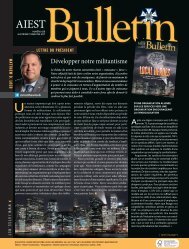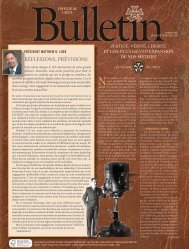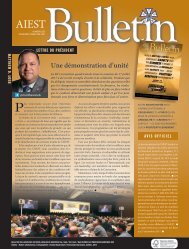IATSE-2nd2018_web
You also want an ePaper? Increase the reach of your titles
YUMPU automatically turns print PDFs into web optimized ePapers that Google loves.
THE FIRST FLICKERS<br />
A similar process was taking place on the production side of<br />
the industry. The first American movies were made in the suburbs<br />
of New York City, especially Fort Lee, New Jersey. It was natural<br />
that stagehands, already familiar with creating and setting scenes<br />
and operating lights, would be called upon to make the movies<br />
happen. In the beginning, there was a great spirit of adventure,<br />
as everyone joined in the freewheeling atmosphere. Stagehands<br />
could suggest how to create a new backdrop to a scene and a<br />
lighting person could pitch a story idea to the producer.<br />
But as the flickers became more successful, the movie-making<br />
process took on a factory-like tone. Producers and theater<br />
owners wanted to tap into the gigantic collective purse of the<br />
movie-going public. The early motion picture pioneers literally<br />
cranked out the movies, at least a reel each week. They were more<br />
interested in efficiency and productivity than in creativity.<br />
Ince Studios, D.W. Griffith, William Fox, and Jesse Lasky<br />
came to the movies with a background in the theater. These<br />
motion picture pioneers naturally turned to the skilled workers<br />
they had worked with in the theaters. Stagehands became<br />
department heads and brought in their union brothers to fill the<br />
jobs on the set. They set up their studios along the craft lines of<br />
the theaters; property people handled props, set painters painted<br />
sets, and electricians set lights. Calcium light operators gladly<br />
took the jobs of projectionists.<br />
These workers were the trail blazers in this new industry and<br />
often ended up shaping the standards for these jobs. As Jesse<br />
Lasky explained:<br />
It occurred to us that we could use Bill [Bowers,<br />
the property man] at the studio to take charge of<br />
obtaining all the odds and ends to dress the sets. I think<br />
Bill established the principle upon which the props<br />
department functions today, namely that a director<br />
gets whatever he asks for without argument, no matter<br />
how crazy or impossible the request.<br />
More than 100 years later, that statement surely sounds<br />
familiar to every IA prop person working today.<br />
SPEARHEADING THE CANADIAN<br />
MOTION PICTURE INDUSTRY<br />
Canada was responsible for a number of important cinematic<br />
milestones. On July 21, 1896, Andrew and George Holland<br />
of Ottawa used the Vitascope to put on<br />
the first public presentation of films in Canada<br />
15






